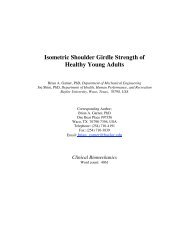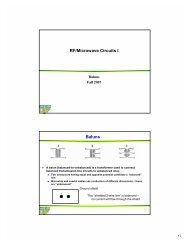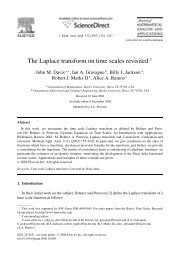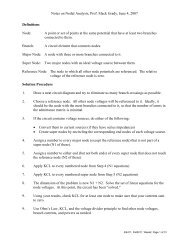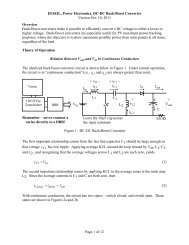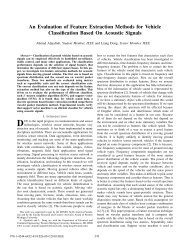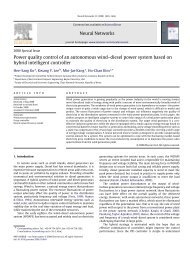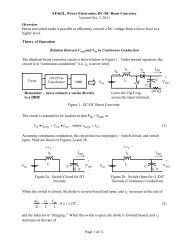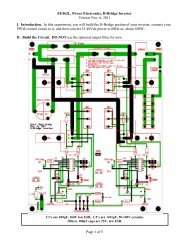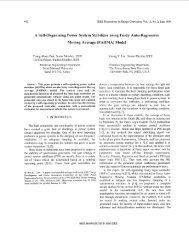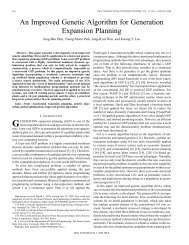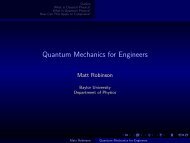Allocation and design of power system stabilizers for ... - ECS
Allocation and design of power system stabilizers for ... - ECS
Allocation and design of power system stabilizers for ... - ECS
Create successful ePaper yourself
Turn your PDF publications into a flip-book with our unique Google optimized e-Paper software.
Electrical Power <strong>and</strong> Energy Systems 26 (2004) 607–618<br />
www.elsevier.com/locate/ijepes<br />
<strong>Allocation</strong> <strong>and</strong> <strong>design</strong> <strong>of</strong> <strong>power</strong> <strong>system</strong> <strong>stabilizers</strong> <strong>for</strong> mitigating<br />
low-frequency oscillations in the eastern<br />
interconnected <strong>power</strong> <strong>system</strong> in Japan<br />
Masachika Ishimaru a, *, Ryuichi Yokoyama a , Oriane Magela Neto b , Kwang Y. Lee c<br />
a Tokyo Metropolitan University, 1-1 Minamiosawa, Hachioji, Tokyo 192-0397, Japan<br />
b FUNREI, Praca Frei Orl<strong>and</strong>o, 170 36307-352 Sao Joao del Rei MG, Brazil<br />
c The Pennsylvania State University, University Park, PA 16802, USA<br />
Abstract<br />
Low-frequency oscillations have been observed on trunk transmission <strong>system</strong>s in Japan, <strong>and</strong> have been the subject <strong>for</strong> studies in fields <strong>of</strong><br />
operation, control, <strong>and</strong> devices by the many <strong>power</strong> <strong>system</strong> utilities. Power <strong>system</strong> <strong>stabilizers</strong> (PSSs) are very effective controllers in<br />
enhancing the damping <strong>of</strong> low-frequency oscillations, since the controllers can increase damping torque <strong>for</strong> inter area modes by introducing<br />
additional signals into the excitation controllers already equipped with generators. In this paper, allocation <strong>of</strong> PSSs in an interconnected<br />
<strong>power</strong> <strong>system</strong> with inter area modes has been determined by an eigenvalue analysis, <strong>and</strong> PSSs <strong>for</strong> the allocated generators have been <strong>design</strong>ed<br />
by a frequency response method. The <strong>design</strong>ed PSSs have been verified in a Japanese <strong>power</strong> <strong>system</strong> st<strong>and</strong>ard model. This test <strong>system</strong> is<br />
created as a st<strong>and</strong>ard model based on the trunk transmission <strong>system</strong>s in the eastern area <strong>of</strong> Japan, <strong>and</strong> reflects characteristic features <strong>of</strong> the real<br />
<strong>power</strong> <strong>system</strong>s; there<strong>for</strong>e, realistic allocation <strong>and</strong> <strong>design</strong> <strong>for</strong> enhancement <strong>of</strong> the stability <strong>of</strong> low-frequency oscillations have been verified.<br />
q 2004 Elsevier Ltd. All rights reserved.<br />
Keywords: Low-frequency oscillation; Power <strong>system</strong> stability; Frequency response method<br />
1. Introduction<br />
Many electric utility <strong>system</strong>s are undergoing restructuring<br />
worldwide. In 1999, Japan also amended the Electricity<br />
Utility Act effective March 2000. This permitted<br />
participation <strong>of</strong> <strong>power</strong> producers <strong>and</strong> suppliers in the<br />
market. It deregulated the retail market partially, opening<br />
competition up to both domestic <strong>and</strong> <strong>for</strong>eign participants.<br />
This may result in a future <strong>power</strong> <strong>system</strong>, which is much<br />
more complicated. Recently, the combined effect <strong>of</strong> various<br />
factors has made it more difficult to maintain <strong>system</strong><br />
stability. These include the increased use <strong>of</strong> heavily loaded<br />
long-distance transmission lines from <strong>power</strong> sources in<br />
remote <strong>and</strong> distant locations, an imbalance <strong>of</strong> <strong>power</strong> stations<br />
in different areas due to environmental <strong>and</strong> cost issues<br />
regarding their construction, <strong>and</strong> the difficulty <strong>of</strong> securing<br />
transmission line routes. In addition to the increased<br />
complication <strong>of</strong> the <strong>system</strong>, the societal requirement to<br />
maintain <strong>and</strong> supply high quality <strong>power</strong> is heightened <strong>and</strong><br />
stabilization has become a significant issue. Also, under<br />
* Corresponding author. Tel.: þ81-3-4586-6361; fax: þ81-3-4586-1185.<br />
E-mail address: ishimaru-masachika@tepsys.co.jp (M. Ishimaru).<br />
the present <strong>system</strong> in Japan, where only conventional<br />
<strong>system</strong> stabilization control devices are being used to damp<br />
oscillation, there is a concern <strong>for</strong> the occurrence <strong>of</strong><br />
low-frequency oscillation phenomena, <strong>and</strong> developing<br />
countermeasures is considered as an urgent task.<br />
Two types <strong>of</strong> oscillation phenomena can occur on the<br />
present <strong>power</strong> <strong>system</strong>. One is where the oscillation <strong>of</strong> one<br />
generator at a specific <strong>power</strong> plant has an influence on the<br />
<strong>system</strong>. This type <strong>of</strong> oscillation is called local-mode<br />
oscillation <strong>and</strong> its behavior is mainly limited to the local<br />
area in the vicinity <strong>of</strong> the <strong>power</strong> plant. It rarely influences<br />
the rest <strong>of</strong> the <strong>system</strong>. It has been known that the local<br />
oscillation is likely to occur when <strong>power</strong> is transmitted over<br />
long-distance transmission lines from a <strong>power</strong> plant at a<br />
remote location. This type <strong>of</strong> <strong>system</strong> can be accurately<br />
modeled using the single-machine-infinite-bus (SMIB)<br />
<strong>system</strong> model [1]. The other case has been known as<br />
inter-area mode oscillation. This is the case where the<br />
low-frequency oscillation is maintained between sets <strong>of</strong><br />
generators in an interconnected <strong>power</strong> <strong>system</strong>. The simplest<br />
type <strong>of</strong> low-frequency oscillation in the inter-area mode is<br />
between two interconnected areas. The inter-area<br />
mode oscillation has a long history. It has been observed<br />
0142-0615/$ - see front matter q 2004 Elsevier Ltd. All rights reserved.<br />
doi:10.1016/j.ijepes.2004.04.007
608<br />
M. Ishimaru et al. / Electrical Power <strong>and</strong> Energy Systems 26 (2004) 607–618<br />
in the tie-line connecting the large Pacific Southwest <strong>and</strong> the<br />
Pacific Northwest in the United States. It has also been<br />
observed on the tie-line connecting the northern Midwest<br />
<strong>and</strong> Canada [2,3]. Observations have also been made <strong>of</strong><br />
low-frequency oscillation at 2.5 s per cycle on the trunk<br />
transmission <strong>power</strong> <strong>system</strong> <strong>of</strong> Eastern Japan[4]. In general,<br />
it is difficult to analyze these inter-area mode oscillations<br />
since many generators <strong>and</strong> complicated network <strong>of</strong><br />
transmission lines are involved. Power <strong>system</strong> <strong>stabilizers</strong><br />
(PSSs) have been shown to be effective in stabilizing the<br />
modes where there are different oscillation frequencies, as in<br />
the above case. The PSS is a control device to improve the<br />
stability <strong>of</strong> the <strong>system</strong> by introducing a supplementary<br />
signal to an automatic voltage regulator (AVR). The AVR is<br />
an exciter control device, which maintains the terminal<br />
voltage <strong>of</strong> the generator at a constant level. Unlike AVR,<br />
PSS is not electromechanical but is a supplementary<br />
signal-generating device. There<strong>for</strong>e, it is cost effective <strong>and</strong><br />
can be easily installed compared with other control devices.<br />
Much research has been done on PSS. Some research has<br />
focused on developing the PSS using multiple signal inputs<br />
such as the generator active <strong>power</strong>, the generator speed,<br />
<strong>and</strong> reactive <strong>power</strong> to maintain the linear characteristics<br />
toward the phase angle on the heavily loaded transmission<br />
<strong>system</strong>, <strong>and</strong> the bus voltage <strong>for</strong> a long distance line from the<br />
generator [5,6]. There are two types <strong>of</strong> methods <strong>for</strong><br />
developing PSSs, where parameter optimization can be<br />
used to damp oscillation between interconnected <strong>system</strong>s.<br />
The first is to determine the parameters <strong>of</strong> PSS with<br />
consideration <strong>for</strong> <strong>system</strong> operations [7]. The second<br />
includes optimization methods using Artificial Neural<br />
Networks (ANN) [8] or genetic algorithms (GA) [9].<br />
The use <strong>of</strong> PSS in <strong>power</strong> <strong>system</strong> has been both<br />
economical <strong>and</strong> successful in improving the <strong>power</strong> <strong>system</strong><br />
stability, <strong>and</strong> is expected to be installed on many<br />
generators connected to the <strong>system</strong>. However, there are<br />
different kind <strong>of</strong> <strong>power</strong> plants connected to the <strong>power</strong><br />
<strong>system</strong>, such as use fossil fuel, hydro <strong>and</strong> nuclear<br />
<strong>power</strong> plants, <strong>and</strong> generators have different characteristics.<br />
In addition, there are pumped storage <strong>power</strong> plants in<br />
actual use. Whether a PSS is to be installed or not<br />
depends, in part, on the type <strong>of</strong> <strong>power</strong> generation. If<br />
low-frequency oscillation is damped by installing an<br />
appropriate number <strong>of</strong> control devices at appropriate<br />
locations within the <strong>power</strong> <strong>system</strong>, even further economic<br />
gain can be expected. For this reason, it is very important<br />
to have a method <strong>for</strong> determining the locations <strong>for</strong> PSS on<br />
a realistic <strong>power</strong> <strong>system</strong> model. To improve the <strong>power</strong><br />
<strong>system</strong> stability <strong>of</strong> the entire <strong>system</strong>, a smaller number <strong>of</strong><br />
PSSs have been <strong>design</strong>ed <strong>and</strong> installed in a real-size<br />
<strong>system</strong> having inter-area mode oscillations.<br />
The allocation <strong>of</strong> PSSs have been per<strong>for</strong>med by using an<br />
eigenvalue analysis on the <strong>system</strong> so that the dominant<br />
generator with the greatest influence on both the <strong>power</strong><br />
<strong>system</strong> stability <strong>and</strong> the low-frequency oscillation becomes<br />
the c<strong>and</strong>idate <strong>for</strong> PSS installation. The proposed<br />
approach <strong>design</strong>ed a PSS <strong>for</strong> this dominant generator with<br />
the capability <strong>for</strong> damping the <strong>system</strong> mode. In the <strong>design</strong>,<br />
the approach used the frequency response method in the<br />
SMIB <strong>system</strong> model. In the application <strong>of</strong> the proposed<br />
method, the paper utilized the public domain East10 Model<br />
published from the Institute <strong>of</strong> Electrical Engineering <strong>of</strong><br />
Japan, which is a st<strong>and</strong>ard model <strong>for</strong> the eastern part <strong>of</strong> the<br />
Japanese interconnection <strong>system</strong> [10].<br />
2. Power <strong>system</strong> model <strong>and</strong> allocation <strong>of</strong> controllers<br />
It would be desirable to create a model to accurately<br />
analyze each <strong>and</strong> every equipment in the <strong>power</strong> <strong>system</strong><br />
that is comparable to the real <strong>system</strong>. However, <strong>power</strong><br />
<strong>system</strong>s are huge <strong>system</strong>s with connections to<br />
multiple generators <strong>and</strong> trans<strong>for</strong>mers <strong>and</strong> complicated<br />
network <strong>of</strong> transmission lines. For this reason, it is<br />
difficult to create a detailed model. The depth <strong>of</strong> the<br />
<strong>system</strong> analysis depends on the size <strong>of</strong> the target <strong>power</strong><br />
<strong>system</strong>, <strong>and</strong> the accuracy <strong>of</strong> the model must be<br />
compromised to some degree.<br />
Local mode oscillation has been known to occur at the<br />
generator connected to the <strong>system</strong> by tie-lines that are<br />
weak <strong>for</strong> the case <strong>of</strong> the infinite-bus model. Analysis <strong>of</strong><br />
local mode oscillation is done using a detailed model<br />
based on the SMIB <strong>system</strong> model. However, inter-area<br />
mode occurs in very large <strong>system</strong> <strong>of</strong> interconnected,<br />
multi-machine <strong>system</strong>s; there<strong>for</strong>e, it is difficult to do a<br />
detailed analysis. In this paper, an aggregated linear<br />
model <strong>of</strong> a multi-machine <strong>power</strong> <strong>system</strong> that does not<br />
involve detailed analysis <strong>of</strong> a multi-machine <strong>power</strong> <strong>system</strong><br />
but is effective <strong>for</strong> developing the transmission line<br />
<strong>system</strong> structure has been used [11].<br />
2.1. Eigenvalue analysis <strong>of</strong> multi-machine <strong>power</strong> <strong>system</strong><br />
In an analysis <strong>of</strong> the <strong>system</strong> stability, eigenvalues <strong>of</strong> a<br />
<strong>power</strong> <strong>system</strong> model have been derived <strong>and</strong> evaluated.<br />
By analyzing eigenvalues, characteristics <strong>of</strong> <strong>system</strong><br />
dynamics are grasped without a time domain simulation.<br />
There<strong>for</strong>e, the eigenvalue analysis is effective in<br />
evaluating the <strong>system</strong> stability <strong>for</strong> a multi-machine<br />
<strong>power</strong> <strong>system</strong> [14,15].<br />
A swing equation <strong>of</strong> the ith generator, which indicates<br />
the energy balance between a mechanical input <strong>and</strong> an<br />
electrical output, is expressed as follows:<br />
d 2<br />
M i<br />
dt 2 d i ¼ Pm i 2 Pe i 2 D i v i<br />
ð1Þ<br />
An active <strong>power</strong> output <strong>of</strong> the ith generator in Eq. (1) is<br />
calculated as:<br />
Pe i ¼ Xn<br />
j¼1<br />
E i E j Y ij cosðu ij 2 d i þ d j Þ<br />
ð2Þ
M. Ishimaru et al. / Electrical Power <strong>and</strong> Energy Systems 26 (2004) 607–618 609<br />
Also, a damping constant <strong>of</strong> each generator is expressed<br />
as belows:<br />
D i ¼e 2 i v 0i<br />
( )<br />
ðX 0 di 2X 00 diÞT 00 doi<br />
X 0 di 2X sin 2 d 0i þ ðX0 qi 2X 00 qiÞT 00 qoi<br />
ei<br />
X 0 qi 2X cos 2 d 0i<br />
ei<br />
In the case <strong>of</strong> the stability analysis, the damping constants<br />
are very important coefficients, because the constants affect<br />
real parts <strong>of</strong> <strong>system</strong> eigenvalues. In a conventional approach<br />
on <strong>power</strong> <strong>system</strong> stability <strong>for</strong> multi-machine <strong>power</strong> <strong>system</strong>,<br />
network reduction has been per<strong>for</strong>med <strong>for</strong> analysis <strong>and</strong><br />
control purpose. This technique is able to deal with<br />
transmission lines, trans<strong>for</strong>mers, loads, <strong>and</strong> other<br />
equipments in the <strong>power</strong> <strong>system</strong> by using the per unit (pu)<br />
method. The <strong>system</strong> eigenvalues have been evaluated by<br />
considering the components <strong>and</strong> structures <strong>of</strong> the <strong>power</strong><br />
<strong>system</strong>; that is to say, the eigenvalues reflect electrical<br />
distances between generators. There<strong>for</strong>e, the <strong>power</strong> <strong>system</strong><br />
stability has been evaluated in the multi-machine <strong>power</strong><br />
<strong>system</strong> by considering the network configurations.<br />
A condition, that all eigenvalues are in the negative real<br />
half <strong>of</strong> the complex plane, has been well known <strong>for</strong> a stable<br />
<strong>system</strong>. Also, an eigenvalue existing nearby the imaginary<br />
axis, influences the <strong>system</strong> stability severely. Moreover, the<br />
imaginary parts <strong>of</strong> <strong>system</strong> eigenvalues dominate the <strong>system</strong><br />
oscillation frequency in the time domain. The parameters in<br />
Eqs. (1)–(3) are listed in Table 1.<br />
2.2. Determination <strong>of</strong> the dominant generator by utilizing<br />
participation factor<br />
The <strong>power</strong> <strong>system</strong> dynamics can be evaluated by<br />
analyzing <strong>of</strong> the <strong>system</strong> eigenvalues. In this evaluation,<br />
Table 1<br />
List <strong>of</strong> parameters in Eqs. (1)–(3)<br />
M i Inertia constant (pu MW s 2 /rad)<br />
d i Rotor angle (rad)<br />
Pm i Mechanical input (pu MW)<br />
Pe i Electrical output (pu MW)<br />
D i Damping constant (pu MW s/rad)<br />
v i Deviation from reference speed (rad/s)<br />
E i Magnitude <strong>of</strong> internal voltage (pu)<br />
Y ij Magnitude <strong>of</strong> admittance between generators (pu)<br />
i <strong>and</strong> j<br />
u ij Phase angle <strong>of</strong> admittance between<br />
(pu)<br />
generators i <strong>and</strong> j<br />
e i Voltage <strong>of</strong> infinite bus (pu)<br />
Xe i External reactance (pu)<br />
d 0i Initial rotor angle <strong>of</strong> infinite bus voltage (rad)<br />
v 0i Rotation speed <strong>of</strong> generator in steady-state (rad/s)<br />
0<br />
Xd i d-Axis transient reactance (pu)<br />
0<br />
Xq i q-Axis transient reactance (pu)<br />
00<br />
Xd i d-Axis subtransient reactance<br />
(pu)<br />
00<br />
Xq i q-Axis subtransient reactance (pu)<br />
00<br />
Tdo i d-Axis subtransient open-circuit time constant (s)<br />
00<br />
Tqo i q-Axis subtransient open-circuit time constant (s)<br />
ð3Þ<br />
a dominant root, which is located near the imaginary axis,<br />
can be recognized. In the case <strong>of</strong> stabilizing the dominant<br />
root by applying an appropriate controller, the <strong>power</strong> <strong>system</strong><br />
stability can be enhanced. This paper proposes an approach<br />
to determine locations <strong>of</strong> generators, which should be<br />
equipped with the controllers. In the approach, a participation<br />
factor is utilized [12]. The participation factor is<br />
effective in finding state variables affecting the dominant<br />
root. The factor is derived from eigenvectors.<br />
First, eigenvector f j is calculated with an eigenvalue l j <strong>of</strong><br />
a <strong>system</strong> matrix Aðn £ nÞ:<br />
F ¼½f 1 ff 2 f···f n Š<br />
Next, a vector c i is defined as below:<br />
C ¼½F 21 Š T ¼½c 1 fc 2 f···fc n Š<br />
In this case, a participation factor p ij is expressed as follows:<br />
p ij ¼ f ij £ c ij<br />
ð6Þ<br />
Here, these two matrices F <strong>and</strong> C have been related as<br />
F £ C T ¼ I; there<strong>for</strong>e:<br />
X n<br />
j¼1<br />
p ij ¼ Xn<br />
j¼1<br />
In a similar way:<br />
X n<br />
i¼1<br />
p ij ¼ 1:0 þ j0:0<br />
f ij £ c ij ¼ 1:0 þ j0:0<br />
The participation factor p ij expresses the influence or<br />
sensitivity upon ith state variable against the eigenvalue<br />
l j ; <strong>and</strong> Eqs. (7) <strong>and</strong> (8) implies the numerical values are<br />
normalized. In these characteristics, the participation factor<br />
is more effective than normal eigenvectors, <strong>and</strong> useful <strong>for</strong><br />
the eigenvalue analysis. In this paper, the state variable<br />
affecting the dominant root is determined by the evaluation<br />
<strong>of</strong> the participation factor; moreover, a dominant generator,<br />
which should be equipped with a PSS controller, is selected.<br />
3. Design <strong>of</strong> <strong>power</strong> <strong>system</strong> stabilizer based<br />
on the frequency response method<br />
This paper aims at allocating <strong>and</strong> <strong>design</strong>ing PSSs against<br />
low-frequency oscillation on the trunk <strong>power</strong> <strong>system</strong> in the<br />
eastern area <strong>of</strong> Japan. The low-frequency oscillation in bulk<br />
<strong>power</strong> <strong>system</strong> is related with inter-area mode. However, it is<br />
difficult to prove the cause <strong>of</strong> the occurrence <strong>of</strong> the<br />
low-frequency oscillation in the bulk <strong>power</strong> <strong>system</strong>. In this<br />
Fig. 1. Single-machine-infinite-bus (SMIB) <strong>system</strong> model.<br />
ð4Þ<br />
ð5Þ<br />
ð7Þ<br />
ð8Þ
610<br />
M. Ishimaru et al. / Electrical Power <strong>and</strong> Energy Systems 26 (2004) 607–618<br />
by assuming the flux linkages <strong>of</strong> the field winding is<br />
constant, as follows:<br />
M<br />
v 0<br />
s 2 Dd þ D v 0<br />
sDd þ KDd ¼ 0<br />
ð9Þ<br />
Fig. 2. Linearized model <strong>of</strong> SMIB <strong>system</strong>.<br />
paper, PSS parameters have been <strong>design</strong>ed based on a<br />
frequency response method <strong>for</strong> a local mode, <strong>and</strong> the<br />
allocation <strong>of</strong> PSS controllers has been determined based on<br />
the inter-area mode.<br />
A PSS <strong>for</strong> the enhancement <strong>of</strong> the local mode is <strong>design</strong>ed<br />
<strong>for</strong> SMIB <strong>system</strong> model shown in Fig. 1. The SMIB <strong>system</strong><br />
model ignores <strong>power</strong> <strong>system</strong> networks beyond the infinite bus;<br />
there<strong>for</strong>e, the model has not reflected the electrical distances,<br />
<strong>for</strong> example components <strong>and</strong> structures <strong>of</strong> transmission lines<br />
<strong>and</strong> other equipments. However, the model is suitable <strong>for</strong> the<br />
<strong>design</strong> <strong>of</strong> PSS parameters, because an exhaustive study on the<br />
generator model has been made already [1].<br />
A generators’ dynamics <strong>for</strong> small-signal stability analysis<br />
in SMIB <strong>system</strong> has been expressed, with linearization<br />
In the equation above, under condition that the solution<br />
calculated in Eq. (10) is not a positive real number, the<br />
dynamics <strong>of</strong> the <strong>system</strong> is stable. In other words, the<br />
condition is that the damping constant D is a positive<br />
number ðD . 0Þ; <strong>and</strong> the synchronizing coefficient K is also<br />
positive ðK . 0Þ:<br />
s ¼ 2D ^ j pffiffiffiffiffiffiffiffiffiffiffiffiffiffiffiffiffi<br />
4Kv 0 M 2 D 2<br />
ð10Þ<br />
2M<br />
Block diagrams <strong>of</strong> damping constant <strong>and</strong> synchronizing<br />
coefficient <strong>of</strong> a generator <strong>and</strong> an AVR with a PSS are shown<br />
in Fig. 2. This figure shows that Dd operates as the<br />
synchronous torque <strong>for</strong> the electrical oscillation <strong>of</strong> the<br />
generator, also Dv delaying 908 in phase than Dd signal,<br />
functions as the damping torque. There<strong>for</strong>e, each torque <strong>of</strong><br />
the generator is, respectively, expressed <strong>and</strong> analyzed in the<br />
<strong>design</strong> <strong>and</strong> evaluation <strong>of</strong> PSS parameters. The constants K 0<br />
<strong>and</strong> D 0 in the figure, respectively, mean the changes in<br />
synchronous torque <strong>and</strong> damping torque due to equipping<br />
with both an AVR <strong>and</strong> a PSS. The synchronous torque <strong>and</strong><br />
damping torque <strong>of</strong> the combined generator <strong>and</strong> the excitation<br />
Fig. 3. IEEJ EAST10 <strong>power</strong> <strong>system</strong> st<strong>and</strong>ard model.
M. Ishimaru et al. / Electrical Power <strong>and</strong> Energy Systems 26 (2004) 607–618 611<br />
Fig. 4. Block diagram <strong>of</strong> automatic voltage regulator.<br />
controller are defined as the synchronizing torque<br />
coefficient K s <strong>and</strong> a damping torque coefficient K d :<br />
4. <strong>Allocation</strong> <strong>of</strong> <strong>power</strong> <strong>system</strong> <strong>stabilizers</strong><br />
in EAST10 model<br />
The allocated <strong>and</strong> <strong>design</strong>ed PSSs in the proposed<br />
approach have been verified in a Japanese <strong>power</strong> <strong>system</strong><br />
st<strong>and</strong>ard model, named ‘East10 Model’ (Fig. 3), released<br />
by the Institute <strong>of</strong> Electrical Engineering <strong>of</strong> Japan. This<br />
test <strong>system</strong> is created as a st<strong>and</strong>ard model based on the<br />
trunk transmission <strong>system</strong>s in the eastern area <strong>of</strong> Japan,<br />
<strong>and</strong> reflects characteristic features in the actual <strong>power</strong><br />
<strong>system</strong>s. In addition, operational conditions in peak load<br />
<strong>and</strong> <strong>of</strong>f-peak load have been set in the <strong>system</strong> model. In<br />
this paper, the peak load condition, where generators<br />
operate in their output margin, is used <strong>for</strong> the allocation <strong>of</strong><br />
PSSs. The generators in the <strong>power</strong> <strong>system</strong> model have<br />
been normally equipped with AVRs shown in Fig. 4. The<br />
normal AVR is not suitable <strong>for</strong> installing the PSS because<br />
<strong>of</strong> its slow operation; there<strong>for</strong>e, a thyristor excited high<br />
per<strong>for</strong>mance AVR shown in Fig. 5 has been installed in<br />
the dominant generator instead <strong>of</strong> the normal AVR. In<br />
view <strong>of</strong> economics, the least number <strong>of</strong> replacing AVRs<br />
<strong>and</strong> installing PSSs is desired. This paper aims at<br />
enhancing the stability against the low-frequency oscillation<br />
by replacing AVRs <strong>and</strong> installing PSSs into the<br />
dominant generator in a test <strong>power</strong> <strong>system</strong>. The EURO-<br />
STAG Ver. 4.0 produced by EDF <strong>and</strong> Tractebel is used in<br />
simulations. A flow chart <strong>of</strong> the proposed approach is<br />
shown in Fig. 6.<br />
Fig. 6. Flow chart <strong>for</strong> allocation <strong>and</strong> <strong>design</strong> <strong>of</strong> PSS.<br />
<strong>of</strong> the <strong>power</strong> <strong>system</strong>. The obtained eigenvalues are shown in<br />
Fig. 7. The eigenvalue analysis takes notice <strong>of</strong> conjugate<br />
eigenvalues; there<strong>for</strong>e, the eigenvalues that take the<br />
positive numbers in the imaginary part are numbered in<br />
Fig. 7. A slant line area in the figure shows that<br />
an eigenvalue in this area has a peculiar oscillation between<br />
2 <strong>and</strong> 4 s per cycle.<br />
4.1. Eigenvalue analysis <strong>of</strong> EAST10 model<br />
In this paper, the eigenvalue analysis has been applied to<br />
the test <strong>power</strong> <strong>system</strong> model The <strong>power</strong> <strong>system</strong> model is<br />
expressed by Eqs. (1)–(3). The eigenvalues <strong>of</strong> the controlled<br />
<strong>system</strong> are derived from these expressions with aggregation<br />
Fig. 5. Block diagram <strong>of</strong> thyristor excited high per<strong>for</strong>mance automatic<br />
voltage regulator.<br />
Fig. 7. System eigenvalues in EAST10 model.
612<br />
M. Ishimaru et al. / Electrical Power <strong>and</strong> Energy Systems 26 (2004) 607–618<br />
Table 2<br />
Eigenvalue <strong>and</strong> oscillation period <strong>of</strong> dominant modes<br />
Mode No. Eigenvalue Oscillation period (s)<br />
Mode 2 20.0590 þ j1.9843 3.1664<br />
Mode 5 20.0350 þ j3.2597 1.9275<br />
The results <strong>of</strong> the eigenvalue analysis indicate that Mode 2<br />
dominates the low-frequency oscillation in EAST10 model,<br />
<strong>and</strong> Mode 5 affects the <strong>power</strong> <strong>system</strong> stability. The Mode 2 is<br />
named ‘Low-Frequency dominant mode’, also Mode 5 is<br />
called ‘Stability dominant mode’ just <strong>for</strong> the sake <strong>of</strong><br />
convenience. When these modes have been stabilized, the<br />
low-frequency oscillation is stabilized <strong>and</strong> the <strong>power</strong> <strong>system</strong><br />
stability is enhanced. The eigenvalues <strong>and</strong> oscillation periods<br />
<strong>of</strong> both dominant modes are listed in Table 2.<br />
4.2. Determination <strong>of</strong> the dominant generator<br />
<strong>for</strong> installing PSS by utilizing participation factor<br />
The modes dominating the low-frequency oscillation <strong>and</strong><br />
the stability have been selected in the eigenvalue analysis.<br />
In the case when a state variable affecting each dominant<br />
mode has been identified, a dominant generator is<br />
determined. The selected generator is a c<strong>and</strong>idate, which<br />
should have the <strong>design</strong>ed PSS installed. In this paper,<br />
the participation factor has been utilized to determine<br />
the dominant generator. The factor is expressed in complex<br />
numbers. The proposed approach deals with the real part<br />
<strong>of</strong> the factor <strong>and</strong> ignores the imaginary part, since<br />
the summation <strong>of</strong> the participation factor in row or column<br />
is 1.0 þ j0.0 by normalization. The factors, ignoring the<br />
imaginary parts, are called participation rates in distinction<br />
from the participation factors. The participation rates <strong>for</strong><br />
EAST10 model is shown in Fig. 8. In the figure, the state<br />
variables are numbered as; ½1 : Dv 1 ; …; 10 : Dv 10 ; 11 :<br />
Dd 221 ; …; 19 : Dd 1021 Š<br />
The results <strong>of</strong> evaluating the participation rates show<br />
that a generator G 9 dominates the low-frequency oscillation<br />
<strong>and</strong> a generator G 6 influences the <strong>power</strong> <strong>system</strong><br />
stability. This paper replaces the AVRs in these dominant<br />
generators with the thyristor-excited high per<strong>for</strong>mance<br />
AVRs, <strong>and</strong> <strong>design</strong>s <strong>and</strong> installs new PSSs into the AVRs<br />
to enhance the damping.<br />
5. Design <strong>of</strong> PSS focused on the dominant generator<br />
<strong>and</strong> verification in the East10 model<br />
Through <strong>system</strong> analysis with the East10 model,<br />
the dominant generator that most effectively damped the<br />
low-frequency oscillation <strong>and</strong> the generator that most<br />
improved the stability <strong>of</strong> the entire <strong>system</strong> have been<br />
identified. In this section, PSSs <strong>for</strong> each <strong>of</strong> these generators<br />
are <strong>design</strong>ed. Here, the AVR is replaced with the thyristorexcited<br />
high per<strong>for</strong>mance AVR shown in Fig. 5. The <strong>design</strong><br />
goal <strong>of</strong> PSS is to improve the damping torque coefficient<br />
Fig. 8. System participation rates in EAST10 model.
M. Ishimaru et al. / Electrical Power <strong>and</strong> Energy Systems 26 (2004) 607–618 613<br />
Fig. 9. PSS block diagram <strong>for</strong> low-freq. dominant generator.<br />
with the least influence on the synchronizing torque<br />
coefficient by adding the PSS signal to AVR. Experience<br />
has shown that to do this requires appropriate damping<br />
torque <strong>of</strong> about 20 pu in the frequency range where the<br />
eigenvalue <strong>of</strong> the frequency <strong>of</strong> the given generator is<br />
0.1–1.0 Hz. However, it is desirable to determine the PSS<br />
parameters by examining the damping torque <strong>of</strong> each<br />
generator. This is because there are differences in capacity<br />
<strong>and</strong> the inertia constant that are dependent on the <strong>power</strong><br />
plant type <strong>and</strong> because there are influences from the<br />
electrical distance between generators, i.e. influence <strong>of</strong><br />
the <strong>system</strong> structure.<br />
The proposed approach <strong>for</strong> allocation <strong>and</strong> <strong>design</strong> <strong>of</strong> PSSs<br />
has been examined in the East10 Model. In the <strong>power</strong><br />
<strong>system</strong> model, the low-frequency oscillation between 2 <strong>and</strong><br />
4 s per cycle has been observed by opening a single-line at<br />
1.0 s <strong>for</strong> 0.07 s nearby node No.36. This paper aims at<br />
damping the low-frequency oscillation by a proper<br />
allocation <strong>and</strong> <strong>design</strong> <strong>of</strong> PSSs.<br />
5.1. Design <strong>of</strong> PSS parameters <strong>for</strong> the low-frequency<br />
dominant generator<br />
This paper <strong>design</strong>s a PSS <strong>for</strong> the low-frequency dominant<br />
generator G 9 assuming node No.19 to be the infinite<br />
bus[13]. A block diagram <strong>of</strong> <strong>design</strong>ed P-Type PSS is<br />
shown in Fig. 9 <strong>and</strong> effects <strong>of</strong> the PSS are shown in Fig. 10.<br />
The <strong>design</strong>ed PSS in Fig. 9 realizing 30 pu <strong>of</strong> the damping<br />
Fig. 10. K d <strong>and</strong> K s in generator No. 9. with P-type PSS.
614<br />
M. Ishimaru et al. / Electrical Power <strong>and</strong> Energy Systems 26 (2004) 607–618<br />
torque coefficient in the low-frequency domain does not<br />
influence the synchronous torque coefficient. Moreover,<br />
Fig. 10 shows the PSS has an effective damping torque<br />
coefficient in a wide range, including oscillation modes <strong>of</strong><br />
generator’s own.<br />
5.2. Verification <strong>of</strong> the low-frequency dominant PSS<br />
in EAST10 model<br />
The <strong>design</strong>ed PSS has been verified <strong>for</strong> the contingency,<br />
breaking out the low-frequency oscillation in the EAST10<br />
Fig. 11. Power <strong>system</strong> oscillations without PSS.
M. Ishimaru et al. / Electrical Power <strong>and</strong> Energy Systems 26 (2004) 607–618 615<br />
Fig. 12. PS oscillations with low frequency dominant PSS.<br />
model. Simulation results <strong>of</strong> not replacing AVRs <strong>and</strong> not<br />
installing PSSs are shown in Fig. 11, <strong>and</strong> results <strong>of</strong> replacing<br />
the AVR <strong>and</strong> installing the <strong>design</strong>ed PSS into the generator<br />
G 9 are shown in Fig. 12. These figures show phase angles <strong>of</strong><br />
arbitrary generators in the top row, electrical outputs<br />
<strong>of</strong> generators in the middle, <strong>and</strong> active <strong>power</strong> flows through<br />
arbitrary transmission lines in the bottom.<br />
By comparison <strong>of</strong> these results, the low-frequency<br />
oscillation at about 4 s per cycle <strong>of</strong> the electrical output <strong>of</strong><br />
generator G 9 in Fig. 11 is damped in Fig. 12 by installing<br />
the <strong>design</strong>ed PSS into the dominant one; there<strong>for</strong>e, the<br />
low-frequency oscillation such as in Fig. 11 are removed<br />
from all outputs in Fig. 12. These results indicate that the<br />
proposed approach can damp the low-frequency oscillation
616<br />
M. Ishimaru et al. / Electrical Power <strong>and</strong> Energy Systems 26 (2004) 607–618<br />
Fig. 13. PSS block diagram <strong>for</strong> stability dominant generator.<br />
by the excitation controller equipped with the generator<br />
related in the dominant eigenvalue. There<strong>for</strong>e, the approach<br />
succeeds allocating <strong>and</strong> <strong>design</strong>ing <strong>of</strong> the PSS against<br />
oscillation frequencies in a multi-machine <strong>power</strong> <strong>system</strong>.<br />
However, the <strong>power</strong> <strong>system</strong> stability has not been<br />
enhanced in Fig. 12 yet, because the stability<br />
dominant mode (Mode 5 in Fig. 7) has not been improved<br />
by this PSS. Mode 5 has the oscillation frequency about 2 s<br />
in the period listed in Table 2; there<strong>for</strong>e, the<br />
oscillation period <strong>of</strong> simulation results in Fig. 12<br />
corresponds with one <strong>of</strong> Mode 5. These results indicate<br />
the necessity <strong>of</strong> installing a PSS into the stability dominant<br />
generator G 6 at the same time.<br />
5.3. Design <strong>of</strong> PSS parameters <strong>for</strong> the stability dominant<br />
generator<br />
A PSS equipped with the stability dominant generator<br />
G 6 is also <strong>design</strong>ed by utilizing SMIB <strong>system</strong> A diagram<br />
<strong>of</strong> a <strong>design</strong>ed PSS <strong>for</strong> G 6 is shown in Fig. 13, <strong>and</strong> effects<br />
<strong>of</strong> the PSS are shown in Fig. 14.<br />
The damping torque coefficient in Fig. 14 shows about<br />
3 pu. This coefficient value is especially regulated <strong>for</strong> the<br />
EAST10 model, because higher damping torque coefficient<br />
has a possibility to make the <strong>system</strong> unstable; there<strong>for</strong>e, the<br />
<strong>design</strong> <strong>of</strong> PSS parameters needs to regulate or adjust against<br />
the dynamics <strong>of</strong> the entire <strong>power</strong> <strong>system</strong>.<br />
Fig. 14. K d <strong>and</strong> K s in generator No. 6 with P-type PSS.
M. Ishimaru et al. / Electrical Power <strong>and</strong> Energy Systems 26 (2004) 607–618 617<br />
5.4. Verification <strong>of</strong> the stability dominant PSS<br />
in EAST10 model<br />
The <strong>design</strong>ed PSS <strong>for</strong> the stability dominant generator G 6<br />
has been verified in the EAST10 model. In the verification,<br />
the low-frequency dominant PSS has been equipped in<br />
the generator G 9 . The damping torque coefficient in Fig. 14<br />
is smaller than one in the low-frequency dominant PSS.<br />
However, the <strong>design</strong>ed PSS succeeded in enhancing the<br />
<strong>power</strong> <strong>system</strong> stability. The results indicate that the <strong>design</strong><br />
<strong>of</strong> PSS needs to consider the <strong>system</strong> configurations, i.e. the<br />
electrical distance between generators (Fig. 15).<br />
Fig. 15. PS oscillations with stability dominant PSS.
618<br />
M. Ishimaru et al. / Electrical Power <strong>and</strong> Energy Systems 26 (2004) 607–618<br />
6. Conclusions<br />
In this paper, the allocation <strong>and</strong> <strong>design</strong> method <strong>of</strong> PSSs<br />
have been proposed to suppress the low-frequency<br />
oscillation in the Eastern area <strong>of</strong> Japan. The proposed<br />
method was applied to the East10 Model, modeled after the<br />
trunk transmission <strong>power</strong> <strong>system</strong> <strong>of</strong> the Eastern area.<br />
The proposed approach created an aggregated model <strong>of</strong><br />
the multi-machine <strong>power</strong> <strong>system</strong> <strong>and</strong> per<strong>for</strong>med the<br />
eigenvalue analysis. Among the eigenvalues identified,<br />
two dominant modes, i.e. low-frequency dominant mode<br />
<strong>and</strong> stability dominant mode have been focused <strong>and</strong><br />
stabilized. These modes are intrinsic to the damping torque<br />
<strong>of</strong> each generator <strong>and</strong> the transmission <strong>system</strong> structure <strong>and</strong><br />
components, i.e. the electrical distance between generators.<br />
The proposed approach has succeeded in determining the<br />
dominant generator with the ability to influence these modes<br />
by evaluating the participation rates to the low-frequency<br />
dominant mode <strong>and</strong> the stability dominant mode.<br />
This paper has examined a <strong>system</strong> by <strong>design</strong>ing <strong>and</strong><br />
configuring a PSS at a particular time <strong>of</strong> the day using the<br />
East10 Model. Since the <strong>power</strong> <strong>system</strong> changes over time,<br />
in the future we will need to examine a robust <strong>design</strong> <strong>and</strong><br />
allocation <strong>of</strong> PSS that ensures stability at various times.<br />
References<br />
[1] de Mello FP, Concordia C. Concepts <strong>of</strong> synchronous machine stability<br />
as affected by excitation control. IEEE Trans Power Apparatus Syst<br />
1969;316–29.<br />
[2] Schleif FP, White JH. Damping <strong>for</strong> the Northwest–Southwest tieline<br />
oscillations an analog study. IEEE Trans Power Apparatus Syst 1966;<br />
PAS-85(12):1239–47.<br />
[3] IEEE Working Group on System Oscillations, Inter Area Oscillation<br />
in Power Systems. IEEE Special Publications 95-Tp-101; 1995.<br />
[4] Michigami T. The development <strong>of</strong> a new two-input PSS to control<br />
low-frequency oscillation in interconnecting <strong>power</strong> <strong>system</strong>s <strong>and</strong> the<br />
study <strong>of</strong> a low-frequency oscillation model. Trans IEE Jpn 1995;<br />
115-B(1):42–61.<br />
[5] Kitauchi Y, Taniguchi H, Shirasaki T, Ichikawa Y, Asano M, Banjo<br />
M. Setting scheme <strong>and</strong> experimental verification <strong>of</strong> multi-input PSS<br />
parameters <strong>for</strong> damping low frequency <strong>power</strong> swing in multi-machine<br />
<strong>power</strong> <strong>system</strong>. Trans IEE Jpn 2002;122-B(1):137–44.<br />
[6] Yoshimura K, Uchida N, Okada T. Development <strong>of</strong> optimizing<br />
method <strong>for</strong> generator excitation parameters considering overall<br />
stability <strong>of</strong> multi-machine <strong>power</strong> <strong>system</strong>. Trans IEE Jpn 2001;<br />
121-B(2):201–9.<br />
[7] Yoshimura K, Uchida N. Optimization method <strong>of</strong> P þ v<br />
PSS’s parameters <strong>for</strong> stability <strong>and</strong> robustness enhancement in a<br />
multi-machine <strong>power</strong> <strong>system</strong>. Trans IEE Jpn 1998;118-B(11):<br />
1312–20.<br />
[8] Salem MM, Zaki AM, Mahgoub OA, El-Zahab EA, Malik OP.<br />
Studies on a multi-machine <strong>power</strong> <strong>system</strong> with a neural network based<br />
on excitation controller. Proceeding <strong>of</strong> IEEE PES Summer Meeting,<br />
July; 2000.<br />
[9] Zhang P, Coonick AH. Coordinated synthesis <strong>of</strong> pss parameters in<br />
multi-machine <strong>power</strong> <strong>system</strong>s using the method <strong>of</strong> inequalities<br />
applied to genetic algorithms. IEEE Trans Power Syst 2000;15(2):<br />
811–6.<br />
[10] The Technical Committee <strong>of</strong> the Institute <strong>of</strong> Electrical Engineering <strong>of</strong><br />
Japan, Japanese Power System Model. IEE <strong>of</strong> Japan, No. 754; 1999.<br />
[11] Anderson PM, Fouad AA. Power <strong>system</strong> control <strong>and</strong> stability. IEEE<br />
Press; 1993.<br />
[12] Kundur P. Power <strong>system</strong> stability <strong>and</strong> control. New York: McGraw-<br />
Hill; 1994.<br />
[13] Ishimaru M, Yokoyama R, Koyanagi K. PADES: ananalytical tool <strong>for</strong><br />
<strong>design</strong>ing <strong>of</strong> <strong>power</strong> <strong>system</strong> stabilizer <strong>for</strong> cross-compound unit. Proc<br />
IEEE PowerTech Porto 2001;.<br />
[14] Lee BH, Lee KY. Dynamic <strong>and</strong> static voltage stability enhancement<br />
<strong>of</strong> <strong>power</strong> <strong>system</strong>s. IEEE Trans Power Syst 1993;8(1):231–8.<br />
[15] Khalde MR, Sarkar AK, Lee KY, Park YM. The modal per<strong>for</strong>mance<br />
measure <strong>for</strong> parameter optimization <strong>of</strong> <strong>power</strong> <strong>system</strong> <strong>stabilizers</strong>. IEEE<br />
Trans Energy Convers 1993;8(4):660–6.



